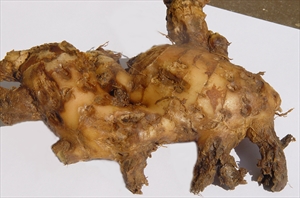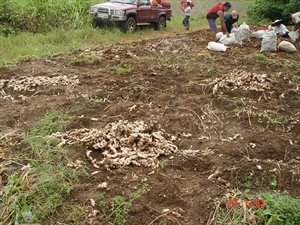Ginger burrowing nematode
Pacific Pests, Pathogens and Weeds - Online edition
Pacific Pests, Pathogens & Weeds
Ginger burrowing nematode (161)
Radopholus similis
Asia, Africa, North, South and Central America, the Caribbean, Europe, Oceania. It is recorded from American Samoa, Australia, Cook Islands, Fiji, French Polynesia, Guam, Federated States of Micronesia, New Caledonia, Niue, Palau, Papua New Guinea, Samoa, Solomon Islands, and Tonga. On ginger, the disease has only been recorded from Guam, Palau, and Yap State (Yap island and Ulithi atoll), Federated States of Micronesia.
Note, in Fiji, the nematode is highly pathogenic on ginger, but less so on banana; in other countries bananas are readily infected (see Fact Sheet no. 257).
The nematode has a large host range, including: banana (see Fact Sheet no. 257), betel nut, black pepper, coconut, coffee, giant swamp taro (see Fact Sheet no. 203), and tea.
A nematode causes the damage; it attacks the roots and burrows into the rhizome. The first sign of the disease are small, water-soaked shallow areas that turn brown, join together, and develop into rots that destroy the rhizomes (Photo 1).
Aboveground, the leaves are yellow, stunted, and the number of shoots is reduced. The plants grow slowly. The topmost leaves dry and die. Affected plants appear to mature earlier than normal, but this is because they die early due to nematode infection.
Eggs are laid in the roots and rhizomes. They hatch in about 10 days into young called 'juveniles', which moult several times as they grow. There are males and females, but the adult males do not feed. The time from egg to adult is about 3 weeks at 25-30°C.
The nematodes enter the roots at the tips, and move into the root and then the rhizome. As they move between the cells, they use a spear-like stylet in their mouths to puncture the cells and feed on the contents. As the cells die, spaces form in the roots and rhizomes and fungi, bacteria and other types of nematodes invade. Rots develop, at first red and later black. As new shoots grow from the seed pieces these, too, are attacked.
Spread of the nematode over short distance occurs in water between soil particles, and in surface water. Over longer distances, the nematodes are spread in soil attached to shoes and rhizomes, and inside infested rhizomes used for planting.
In Fiji, yield reductions of 40% have been found when 50% of the plants are attacked. The amount of rejected rhizomes left in the field after harvest is an indication of the seriousness of this disease (Photo 2). Burrowing continues in storage, increasing the losses that occur in the field from this nematode.
Look for patches of unhealthy yellow leaves. Look for dead roots and/or decay to large parts of the root system; look for rots over the surface of the rhizomes, small, sunken and water-soaked (greyish) at first, developing into large brown deep rots. Look for patches of plants that dry up and die early.
QUARANTINE
Countries should consider the risk of unrestricted importations of ginger from Fiji, especially as a race of the nematode may exist that is specific to ginger, and different from the one that infects banana.
CULTURAL CONTROL
Cultural control is particularly important in the management of this disease; in fact, it is the only way to manage it:
- Planting material:
- Use 'clean' planting material: If possible, use only 'seed' from healthy fields where the disease has not been found. If this is not possible, treat seed with hot water.
- Hot water treatment: After selection of what looks like healthy seed, place it in hot water at 51°C for 10 minutes. Put the seed in bags or sacks, heat the water in e.g., a 44-gallon drum, raise the temperature to 52°C, and put the ginger in the water; remove it after 10 minutes. Do not guess the temperature and the time; use a thermometer and a watch.
- Poultry manure: Apply manure 6-8 weeks before planting at 20 t/ha.
- Crop rotation: Plant ginger after crops of taro and cassava.
- Weeds: Keep weeds to a minimum, as many are hosts of the nematode.
RESISTANT VARIETIES
None known
CHEMICAL CONTROL
Chemical control is not appropriate for the control of this disease.
AUTHOR Grahame Jackson
Information from Department of Agriculture, Fisheries and Forestry (2013) Final import risk analysis report for fresh ginger from Fiji. Department of Agriculture, Fisheries and Forestry, Canberra (https://www.agriculture.gov.au/biosecurity/risk-analysis/memos/2013/ba2013-03-final-ira-ginger-fiji); and from CABI (2013) Radopholus similis (burrowing nematode). Crop Protection Compendium. (https://www.cabi.org/cpc/datasheet/46685#toBigImage17653). Photos 1&2 Mike smith, Department of Agriculture, Fisheries and Forestry, Maroochy Research Station, Nambour, Queensland.
Produced with support from the Australian Centre for International Agricultural Research under project PC/2010/090: Strengthening integrated crop management research in the Pacific Islands in support of sustainable intensification of high-value crop production, implemented by the University of Queensland and the Secretariat of the Pacific Community.





